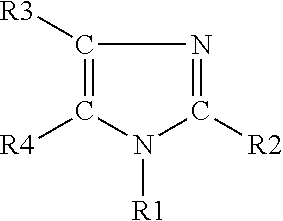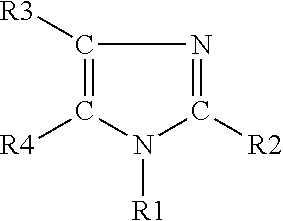Stabilized polyurethane polyol blends containing halogenated olefin blowing agent
a technology of halogenated olefin and polyurethane, which is applied in the field of stabilized polyurethane polyol blends containing halogenated olefin blowing agent, can solve the problems of low energy efficiency, hydrocarbons such as pentane isomers, and inability to react with halogenated olefin, so as to achieve balanced catalytic activity, less reactivity, and better catalytic performan
- Summary
- Abstract
- Description
- Claims
- Application Information
AI Technical Summary
Benefits of technology
Problems solved by technology
Method used
Image
Examples
example 1
[0054]164.2 grams of 2-methyl imidazole were added to 400 milliliters of toluene in a 1.5 liter flask. 116.0 grams of propylene oxide were then added to the flask equipped with a condensation column over 1 hour period. During this period, the flask was agitated and maintained at approximately 80° C. 271.8 grams of N-hydroxypropyl-2-methyl imidazole was recovered after removing the solvent from the reaction.
example 2
[0055]136.2 grams of imidazole were added to 300 milliliters of toluene in a 1.5 liter flask. 88.0 grams of ethylene oxide were then added to the flask equipped with a condensation column. The flask was agitated, after removing solvent, 206.1 grams of N-hydroxyethyl imidazole was recovered from the reaction.
TABLE 1Summary of Example 1 and 2Example 1Example 22-methyl imidazole: 164.2 gImidazole: 136.2 gPropylene oxide: 116.0 gEthylene oxide: 88.0 gN-hydroxypropyl-2-methylN-hydroxyethylimidazole:imidazole: 271.8 g206.1 g
examples 1 and 2
show the almost complete reaction between the imidazole and the oxide.
PUM
| Property | Measurement | Unit |
|---|---|---|
| boiling points | aaaaa | aaaaa |
| wt % | aaaaa | aaaaa |
| wt % | aaaaa | aaaaa |
Abstract
Description
Claims
Application Information
 Login to View More
Login to View More - R&D
- Intellectual Property
- Life Sciences
- Materials
- Tech Scout
- Unparalleled Data Quality
- Higher Quality Content
- 60% Fewer Hallucinations
Browse by: Latest US Patents, China's latest patents, Technical Efficacy Thesaurus, Application Domain, Technology Topic, Popular Technical Reports.
© 2025 PatSnap. All rights reserved.Legal|Privacy policy|Modern Slavery Act Transparency Statement|Sitemap|About US| Contact US: help@patsnap.com


